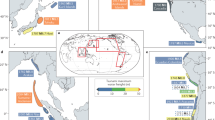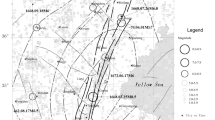Abstract
Seismic energy release is dominated by the underthrusting earthquakes in subduction zones, and this energy release is further concentrated in a few subduction zones. While some subduction zones are characterized by the occurrence of great earthquakes, others are relatively aseismic. This variation in maximum earthquake size between subduction zones is one of the most important features of global seismicity. Previous work has shown that the variation in maximum earthquake size is correlated with the variation in two other subduction zone properties: age of the subducting lithosphere and convergence rate. These two properties do not explain all the variance in maximum earthquake size. I propose that a third subduction zone property, “trench sediments”, explains part of the remaining variance in maximum earthquake size. Subduction zones are divided into two groups: (1) those with excess trench sediments, and (2) those with horst and graben structure at the trench. Thirteen of the 19 largest subduction zone events, including the three largest, occur in zones with excess trench sediments. About half the zones with excess trench sediments are characterized by great earthquake occurrence. Most of the other zones with excess trench sediments but without great earthquakes are predicted to have small earthquakes by the age-rate correlation. Two notable exceptions are the Oregon-Washington and Middle America zones. Overall, the presence of excess trench sediments appears to enhance great earthquake occurrence. One speculative physical mechanism that connects trench sediments and earthquake size is that excess trench sediments are associated with the subduction of a coherent sedimentary layer, which at elevated temperature and pressure, forms a homogeneous and strong contact zone between the plates.
Similar content being viewed by others
References
Aki, K. (1979),Characterization of barriers on an earthquake fault, J. Geophys. Res.84, 6140–6148.
Aki, K.,Strong-motion seismology, in:Earthquakes: Observation, Theory, and Interpretation (edited by H. Kanamori and E. Boschi) (North Holland, New York 1983) pp. 223–250.
Ando, M. (1975),Source mechanisms and tectonic significance of historical earthquakes along the Nankai trough, Japan, Tectonophysics27, 119–140.
Armstrong, R. C. (1981),Radiogenic isotopes: the case for crustal recycling on a near-steady-state no-continental-growth earth, Phil. Trans. Roy. Soc. LondonA301, 443–472.
Beck, S. L. andL. J. Ruff (1984),The rupture process of the great 1979 Colombia earthquake: evidence for the asperity model, J. Geophys. Res.89, 9281–9291.
Beck, S. L. andL. J. Ruff (1987),Rupture process of the great 1963 Kurile Islands earthquake sequence: asperity interaction and multiple event rupture, J. Geophys. Res.92, 14,123–14,138.
Ben-Menahem, A. (1977),Renormalization of the magnitude scale, Phys. Earth Planet. Int.15, 315–340.
Biju-Duval, B., P. Le Quellec, A. Mascle, V. Renard, andP. Valery (1982),Multibeam bathymetric survey and high resolution seismic investigations on the Barbados Ridge complex (eastern Caribbean): A key to the knowledge and interpretation of an accretionary wedge, Tectonophysics86, 275–304.
Chapple, W. M. andD. W. Forsyth (1979),Earthquakes and bending of plates at trenches, J. Geophys. Res.84, 6729–6749.
Das, S. andK. Aki (1977),Fault planes with barriers: A versatile earthquake model, J. Geophys. Res.82, 5658–5670.
Fedotov, S. A. (1965),Regularities of the distribution of strong earthquakes of Kamchatka, the Kurile Islands, and northeastern Japan, Trudy Inst. Fiz. Zemli Akad. Nauk. SSSR36, 66–93.
Fitch, T. J., R. G. North, andM. W. Shields, (1981),Focal depths and moment tensor representations associated with the great Sumba earthquake, J. Geophys. Res.86, 9357–9374.
Gutengerg, B. andC. F. Richter,Seismicity of the Earth (Princeton University Press, Princeton, N.J., 2nd ed., 1954) 310 pp.
Heaton, T. H. andS. H. Hartzell (1988),Estimation of strong ground motions from hypothetical earthquakes on the Cascadia subduction zone, Pacific Northwest, Pure and Appl. Geophys.129, 1/2, 133–203.
Heaton, T. H. andH. Kanamori (1984),Seismic potential associated with subduction in the northwestern United States, Bull. Seism. Soc. Am.74, 933–941.
Hilde, T. W. C. (1983),Sediment subduction versus accretion around the Pacific, Tectonophysics99, 381–397.
House, L. S., L. R. Sykes, J. N. Davies, andK. H. Jacob,Identification of a possible seismic gap near Unalaska Island, eastern Aleutians, Alaska, inEarthquake Prediction, an International Review (edited by D. W. Simpson and P. G. Richards) (American Geophysical Union, Washington, D.C. 1981) pp. 81–92.
Isacks, B., J. Oliver, andL. Sykes (1968),Seismology and the new global tectonics, J. Geophys. Res.73, 5855–5899.
Jarrard, R. D. (1986),Relations among subduction parameters, Rev. Geophys.24, 217–284.
Kanamori, H. (1971a),Great earthquakes at island arcs and the lithosphere, Tectonophysics12, 187–198.
Kanamori, H. (1971b),Seismological evidence for a lithospheric normal faulting—the Sanriku earthquake of 1933, Phys. Earth Planet. Int.4, 289–300.
Kanamori, H. (1977),The energy release in great earthquakes J. Geophys. Res.82, 2981–2987.
Kanamori, H. (1978),Quantification of earthquakes, Nature271, 411–414.
Kanamori, H.,The nature of seismicity patterns before large earthquakes, inEarthquake Prediction, an International Review (edited by D. W. Simpson and P. G. Richards) (American Geophysical Union, Washington D.C., 1981) pp. 1–19.
Kanamori, H.,Global seismicity, inEarthquakes: Observation, Theory, and Interpretation (edited by H. Kanamori and E. Boschi) (North Holland, New York, 1983) pp. 596–608.
Kanamori, H. andD. L. Anderson (1975),Theoretical basis of some empirical relations in seismology, Bull. Seism. Soc. Am.65, 1073–1095.
Kanamori, H. andG. S. Stewart (1978),Seismological aspects of the Guatemala earthquake of February 4, 1976, J. Geophys. Res.83, 3427–3434.
Karig, D. E. andR. W. Kay (1981),Fate of sediments on the descending plate at convergent margins, Phil. Trans. Roy. Soc. LondonA301, 443–472.
Karig, D. E. andG. F. Sharman (1975),Subduction and accretion in trenches, Geol. Soc. Am. Bull.86, 377–389.
Kelleher, J. (1972),Rupture zones of large South American earthquakes and some predictions, J. Geophys. Res.77, 2087–2103.
Kelleher, J., J. Savino, H. Rowlett, andW. McCann (1974),Why and where great thrust earthquakes occur along island arcs, J. Geophys. Res.79, 4889–4899.
Kelleher, J., L. Sykes, andJ. Oliver (1973),Possible criteria for predicting earthquake locations and their application to major plate boundaries of the Pacific and the Caribbean, J. Geophys. Res.78, 2547–2585.
Kulm, L. D. andG. A. Fowler,Oregon continental margin structure and stratigraphy—a test of the imbricate thrust model, inThe Geology of Continental Margins (edited by C. A. Burk and C. L. Drake) (Springer, New York, 1974) pp. 261–283.
Kulm, L. D., W. J. Schweller, andA. Masias,A preliminary analysis of the subduction processes along the Andean continental margin, 6° to 45°S, inIsland Arcs, Deep Sea Trenches, and Back-Arc Basins (edited by M. Talwani and W. C. Pitman III) (American Geophysical Union, Washington D.C., 1977) pp. 285–302.
Lay, T., H. Kanamori, andL. Ruff (1982),The asperity model and the nature of large subduction zone earthquakes, Earthquake Pred. Res.1, 3–71.
McCann, W. R., S. P. Nishenko, L. R. Sykes, andJ. Kraus (1979),Seismic gaps and plate tectonics: Seismic potential for major plate boundaries, PAGEOPH117, 1087–1147.
Mogi, K. (1969),Relationship between the occurrence of great earthquakes and tectonic structures, Bull. Earthquake Res. Inst., Tokyo Univ.47, 429–451.
Newcomb, K. R. andW. R. McCann (1987),Seismic history and seismotectonics of the Sunda arc, J. Geophys. Res.92, 421–439.
Nishenko, S. P. (1985),Seismic potential for large and great interplate earthquakes along the Chilean and southern Peruvian margins of South America: A quantitative reappraisal, J. Geophys. Res.90, 3589–3616.
Nishenko, S. P. andW. R. McCann,Seismic potential for the world's major plate boundaries: 1981, inEarthquake Prediction, an International Review (edited by D. W. Simpson and P. G. Richards) (American Geophysical Union, Washington D. C., 1981), pp. 20–28.
Nur, A. andM. Israel (1980),The role of heterogeneities in faulting, Phys. Earth Planet. Int.21, 225–236.
Plafker, G. andJ. C. Savage (1970),Mechanism of the Chilean earthquakes of May 21 and 22, 1960, Geol. Soc. Am. Bull.81, 1001–1030.
Ruff, L. J.,Fault asperities inferred from seismic body waves, inEarthquakes: Observation, Theory, and Observation (edited by H. Kanamori and E. Boschi) (North Holland, New York, 1983) pp. 251–276.
Ruff, L. andH. Kanamori (1980),Seismicity and the subduction process, Phys. Earth Planet. Int.23, 240–252.
Ruff, L. andH. Kanamori (1983a),Seismic coupling and uncoupling at subduction zones, Tectonophysics99, 99–117.
Ruff, L. andH. Kanamori (1983b),The rupture process and asperity distribution of three great earthquakes from long-period diffracted P-waves, Phys. Earth Planet. Int.31, 202–230.
Ruff, L., H. Kanamori, andL. Sykes (1985),The 1957 great Aleutian earthquake, EOS66, 298 (abstract).
Scholl, D. W., M. S. Marlow, andA. K. Cooper,Sediment subduction and offscraping at Pacific margins inIsland Arcs, Deep Sea Trenches, and Back-arc, Basins (edited by M. Talwani, and W. C. Pitman III) (American Geophysical Union, Washington D.C., 1977) pp. 199–210.
Scholl, D. W., R. Von Huene, T. L. Vallier, andD. G. Howell (1980),Sedimentary masses and concepts about tectonic processes at underthrust margins, Geology8, 564–568.
Schwartz, S. Y. andL. J. Ruff (1987),Asperity distribution and earthquake occurrence in the southern Kurile Islands arc, Phys. Earth Planet. Int.49, 54–77.
Sykes, L. R. (1971),Aftershock zones of great earthquakes, seismicity gaps, and earthquake prediction for Alaska and the Aleutians, J. Geophys. Res.76, 8021–8041.
Spence, W. (1986),The 1977 Sumba earthquake series: evidence for slab pull force acting at a subduction zone, J. Geophys. Res.91, 7225–7239.
Tajima, F. andH. Kanamori (1985),Global survey of aftershock area expansion patterns, Phys. Earth Planet. Int.40, 77–134.
Uyeda, S. andH. Kanamori (1979),Back-arc opening and the mode of subduction, J. Geophys. Res.84, 1049–1061.
Von Huene, R., M. Langseth, N. Nasu, andH. Okada (1982),A summary of the Cenozoic tectonic history along the IPOD Japan Trench transect, Geol. Soc. Am. Bull.93, 829–846.
Wang, C. (1980),Sediment subduction and frictional sliding in a subduction zone, Geology8, 530–533.
Author information
Authors and Affiliations
Rights and permissions
About this article
Cite this article
Ruff, L.J. Do trench sediments affect great earthquake occurrence in subduction zones?. PAGEOPH 129, 263–282 (1989). https://doi.org/10.1007/BF00874629
Received:
Revised:
Accepted:
Issue Date:
DOI: https://doi.org/10.1007/BF00874629




